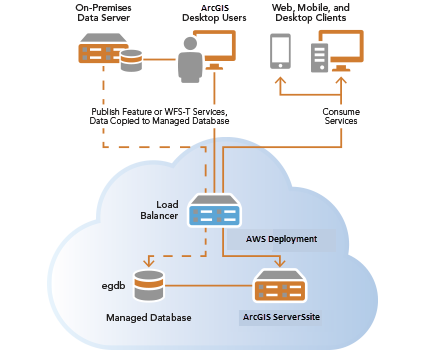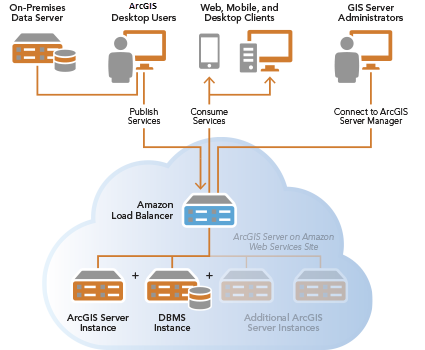Geodatabases store spatial and nonspatial data. Geodatabases on Amazon Web Services (AWS) instances are intended to store data you are serving from your ArcGIS Server sites on AWS. You can use file, workgroup, or enterprise geodatabases.
Note:
Geodatabases in AWS instances are not intended to be accessed directly from on-premises ArcGIS clients as performance will be far slower than when the geodatabases are accessed from ArcGIS clients on AWS.
Esri sample AWS CloudFormation templates provide options to include enterprise geodatabases in an Amazon Relational Database Service (RDS) with your stand-alone ArcGIS GIS Server site. If you create your site through the AWS Management Console using the Esri Amazon Machine Images (AMI), you can create your own file, workgroup, or enterprise geodatabases and register them with the ArcGIS Server site.
To understand the data store options available when publishing data, see the ArcGIS Server topic About registering your data with ArcGIS Server
The following sections describe each type of geodatabase you can use with ArcGIS Server sites on AWS.
Enterprise geodatabases
When you launch a stand-alone GIS Server site using one of the Esri CloudFormation templates and provide an ArcGIS GIS Server enterprise edition license, two geodatabases are created for you at 10.6—egdb and geodata. At 10.6.1, only the egdb geodatabase is created.
At 10.6, the egdb geodatabase is registered as the GIS Server site's managed database. When you publish feature or WFS-T services to a site that has a managed database, the data can be copied from the geodatabase that contains the map source data to the egdb geodatabase. This data is dependent on the service; when you delete the feature or WFS-T service, the data is deleted from the egdb geodatabase.
If you publish an editable feature or WFS-T service, clients can connect to the feature service to edit the data.

At 10.6.1, the egdb geodatabase is added as a registered database to the GIS Server site. You need to move data into this geodatabase to store data in it on AWS. When you publish services from this data or later delete these services, the data remains in the egdb geodatabase.
The geodata geodatabase created with 10.6 is intended for use as a replicated geodatabase. You can register the geodata geodatabase with the GIS Server site. When you do, designate the geodata geodatabase as a server database connection that is not the same as your publisher database connection (the publisher geodatabase being your on-premises enterprise geodatabase) and create a geodata service. You can replicate data from your on-premises enterprise geodatabase to the geodata geodatabase through the geodata service.
When you publish a feature or WFS-T service that includes the replicated data, edits made to the data through the feature service can be synchronized with the geodata service, updating the data in your on-premises enterprise geodatabase. Similarly, you can continue to edit your on-premises data and use the geodata service to synchronize those changes to the data in the geodata geodatabase.

When you opt to include a database management system with your site created using Esri CloudFormation templates, the enterprise geodatabases are created in Amazon RDS instances.
The following diagram shows a GIS Server site on AWS with ArcGIS Server and the database management system on separate AWS instances, with two additional GIS Server installations on AWS instances available when CPU usage exceeds a specified threshold.

See Geodatabases in PostgreSQL included with ArcGIS Enterprise on Amazon Web Services and Geodatabases in SQL Server included with ArcGIS Enterprise on Amazon Web Services for more information on using an enterprise geodatabase with your GIS Server site on AWS.
If you use the Esri AMIs and AWS Management Console to create your stand-alone GIS Server site, you can create your own enterprise geodatabases in PostgreSQL, Amazon RDS for PostgreSQL, or Amazon RDS for SQL Server.
Workgroup geodatabases
If you have an ArcGIS Enterprise workgroup edition license, you can use the Esri Windows AMI and AWS Management Console to create a stand-alone GIS Server site on an EC2 instance that includes an instance of SQL Server Express.
The SQL Server Express instance (database server) comes with two geodatabases already created: egdb and geodata. The egdb geodatabase is registered as the GIS Server site's managed database. When you publish feature or WFS-T services to a site that has a geodatabase registered in this way, the data is copied from your source to the egdb geodatabse.
The geodata geodatabase is intended for use as a replicated geodatabase. You can register the geodata geodatabase as a database connection that is different from the publisher database connection and create a geodata service from it. Through the geodata service, you can synchronize data from your on-premises enterprise or workgroup geodatabase to the geodata geodatabase.
Workgroup geodatabases only support Windows authentication. Two operating system users are automatically added to the SQL Server Express instance as server administrators: Administrator and ArcGIS. Both logins are dbo in the egdb and geodata geodatabases.
See Workgroup geodatabases included with ArcGIS Enterprise on Amazon Web Services for more information on using these geodatabases on AWS.
File geodatabases
See File geodatabases used with ArcGIS Enterprise on Amazon Web Services.